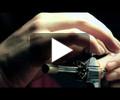Tortoise Automaton
Raúl Pagès creates a fabulous piece automated: The Tortoise
| Rating: 51 %1000 with 150 votes |
 Yes 1
Yes 1  Not so much 0
Not so much 0
- Summary
THE TORTOISE AUTOMATON
A unique masterpiece by Raúl Pagès
PIECE UNIQUE
The "Tortoise" automaton moves thanks to a mechanism similar to a watch movement. With this unique piece, entirely manufactured in Switzerland, the independent brand PAGÈS brings back to life the forgotten tradition of prestigious automatons.
The “Tortoise” automaton is the result of several years of work that have gone into the search for excellence. All the parts that go into the movement (a total of over 300) were produced by craftsmen in the greatest respect of watchmaking traditions. Great care has been given to the finishing : hand bevelling, guilloche work, Côtes de Genève.
The shell was engraved and enamelled by craftsmen in the area. The shell, the legs and the head are made out of 18-cts gold. Diamonds have been inserted in the claws and the eyes are decorated with sapphires. A key is used to wind up the Tortoise which then moves forward while moving its legs and head.
This piece is unique, and is the first of a very limited series of tortoises each of which will be different and exclusive. The tortoise is the emblem of longevity, wisdom and perseverance, values that Raúl Pagès seeks to express in his automata.
You can see here the video of this wonderful piece - Tortoise Automaton
Raúl Pagès History
Creator of automata & Master watchmaker
Raúl Pagès grew up in the Val-de-Ruz region of Neuchâtel in the Jura Arc, cradle of the Swiss watchmaking industry. He completed his education at the CIFOM Technical School in Le Locle with a dual specialization in restoration and horological complications and later in horological construction.
As from 2006 he worked as a watchmaker at Parmigiani Fleurier, which brought him into close contact with numerous watches, clocks and automata, all unique timepieces that are part of the watchmaking heritage. In close proximity to these highly exceptional art objects, Raúl developed a passion for quality movements, meticulous finish and fine ornamentation. There was, however, one particular type of object that held his fascination: elaborate animal automata. He restored several famous Fabergé eggs, some of which contained mechanical animals such as a peacock or a swan, as well as richly decorated 19C automata showcasing a mouse, frog and a caterpillar. Raúl Pagès was especially struck by the beauty and finesse of these objects combining both mechanical ingenuity and decorative creativity.
After six years devoted to the restoration of antique clocks, he decided to turn to creating state-of-the-art automata. He developed a philosophy that became the guiding principle of his work: contribute to historical continuity and uphold the centuries old tradition of prestigious automata. Putting into practice the experience and knowledge gained during his work as a restorer, he creates objects that are in keeping with the times, unique pieces using contemporary design and the finest materials. His vision is based on the core values of creativity, innovation and expertise applied to miniature works of art that both charm and entertain by their playful aspect and aesthetic refinement.
PAGÈS AUTOMATA
The revival of a lost art
Master watchmaker, Raúl Pagès, is specialized in high-end automata, art pieces powered by a mechanism very similar to a haute horlogerie movement .
The animal automata contain micro-mechanisms that imitate the natural movements of the animal, such as its gait or the way it turns its head. The ingenuity of the mechanism is combined with the sumptuous decor of the shell made from fine materials (gold, diamonds, precious stones), while the engraving, enamelling and gem-setting are carried out by specialized craftsmen. Many techniques, such as chamfering of hand-made parts, polished screws, bridge graining and rhodium-plating, are used on each timepiece to obtain an exquisite finish.
This type of automata first appeared in the 17C. In the next two centuries, automata reached the peak of their popularity, especially with pieces created by such ingenious watchmakers as Jaquet-Droz, specialised in songbirds and androids, Henri Maillardet, creator of several zooids and Karl Fabergé, who incorporated animal automata into some of his eggs. Originally intended for world leaders – European kings, Chinese emperors, Russian czars and Turkish sultans – the automats also enthralled the crowds that thronged to the exhibitions where these exceptional objects were displayed.
The manufacture of these celebrated automata ceased in the early 20C. Wishing to revive this ancient tradition, Raúl Pagès today creates contemporary designs inspired by the masterpieces of the past. Each PAGÈS automaton is a unique piece of art work, and can be distinguished by the quality of its movement and richly detailed finish.
FOR MORE INFORMATIONS:
SITE:
www.pages-automates.com















